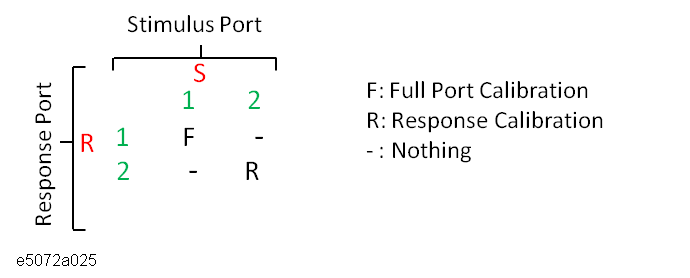
Other topics about Calibration
You can check the execution status of error correction for each channel with the error correction status.
The error correction status is indicated in the channel status bar in the lower part of the window by the symbols in the below table.
|
Symbol |
Execution status of error correction |
|
Cor (displayed in blue) |
Error correction: ON (enabled for all traces) |
|
Cor (displayed in gray) |
Error correction: ON (enabled for some traces) |
|
Off (displayed in gray) |
Error correction: OFF |
|
--- (displayed in gray) |
Error correction: ON (no calibration data) |
|
C? (displayed in blue) |
Error correction: ON (Interpolation is being executed or the IF bandwidth, power level, power range, sweep time, sweep delay time, or sweep type is different from that when the calibration was executed.) |
|
C! (displayed in blue) |
Error correction: ON (Extrapolation is being executed). |
An asterisk (*) at the upper-right of the softkey indicates that the existing calibration coefficient will be cleared if you select the test port and execute acquisition of the calibration coefficient (clicking Done).
You can check the status of the actually executed error correction for each trace at the trace status area.
For a trace for which error correction is executed, the applied calibration type is indicated at the trace status area by the symbols shown in the table below.
|
Symbol |
Calibration type |
|
RO |
Open response calibration |
|
RS |
Short response calibration |
|
RT |
Thru response calibration |
|
ER |
Enhanced response calibration |
|
F1 |
1-port calibration |
|
F2 |
Full 2-port calibration/2-port TRL calibration |
If none of the symbols described above is displayed, error correction is not executed for the trace.
You can check the acquisition status of the calibration coefficient for each channel with the calibration property.
The calibration property displays the acquisition status of the calibration coefficient between test ports for each channel in matrix format. The following figure shows an example of when the calibration coefficients have been acquired for the 1-port calibration for test port 1 and response calibration for test port 2.
Example of calibration property display

Follow these steps to turn ON/OFF the calibration property display.
Press Channel Next/Channel Prev to select the channel for which you want to turn ON/OFF the calibration property display.
Press Cal.
Click Property. Each press toggles the ON/OFF setting.
In the following cases, already acquired calibration coefficients are cleared.
Executing preset clears all calibration coefficients.
If S-Parameter is required to calculate the calibration coefficient for the specified calibration type and test ports and those required for the existing calibration coefficient overlap, executing the acquisition of the calibration coefficient (measuring necessary data and then clicking the Done softkey) clears the calibration coefficient of the overlapping S-Parameter. Take the Example of calibration property display as an example: If you acquire the calibration coefficient of the 1-port calibration for test port 2, neither calibration coefficient is cleared. On the other hand, if you acquire the calibration coefficient for the full 2-port calibration between test ports 1 and 2, the already acquired calibration coefficient of the full 2-port calibration between test ports 1 and 2 are cleared.